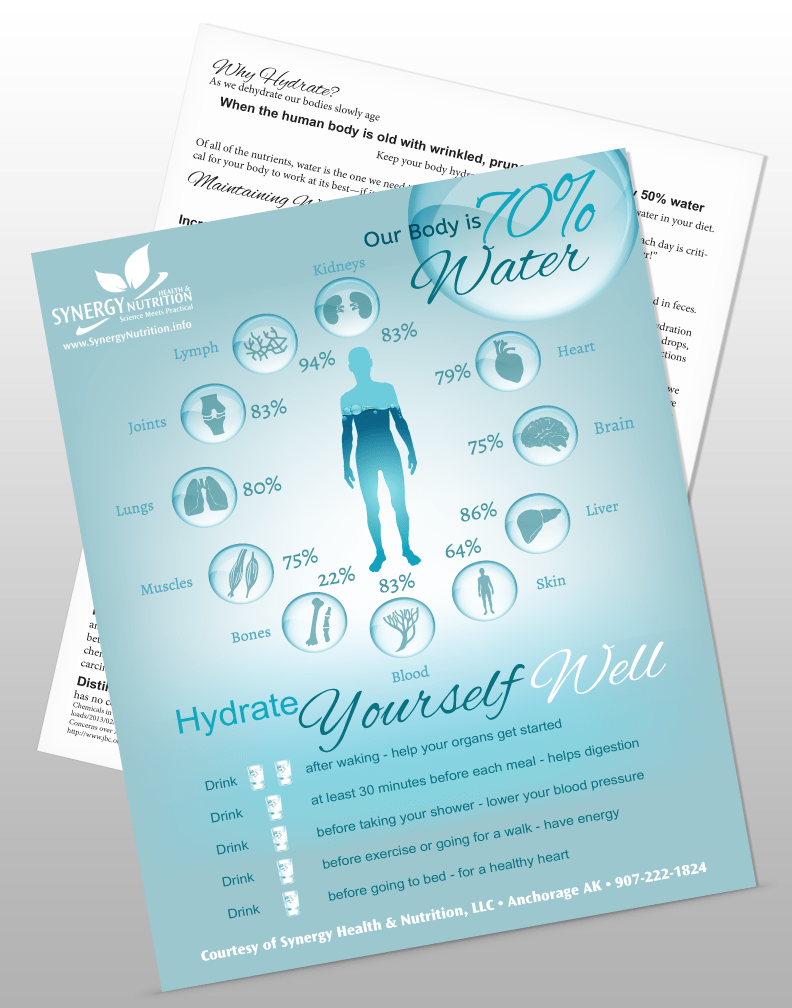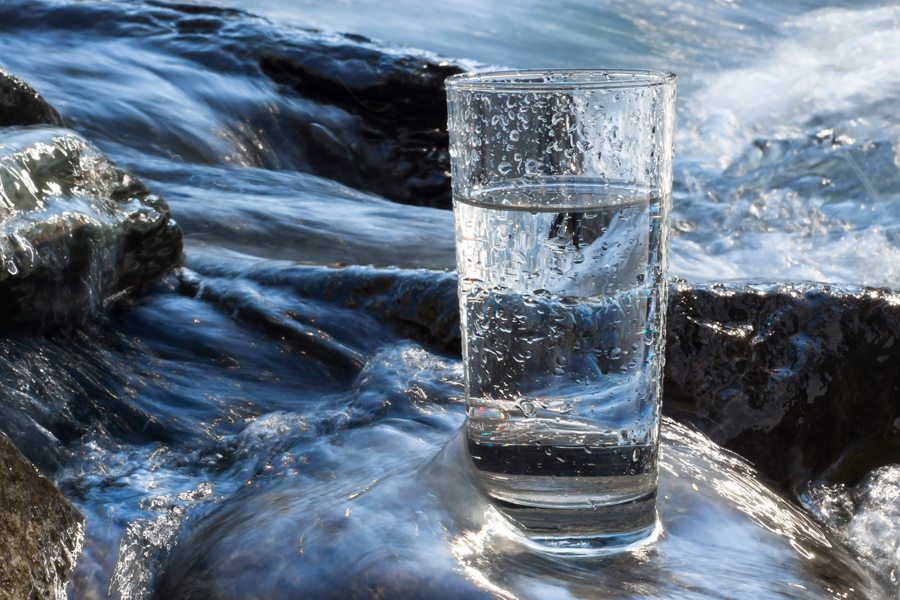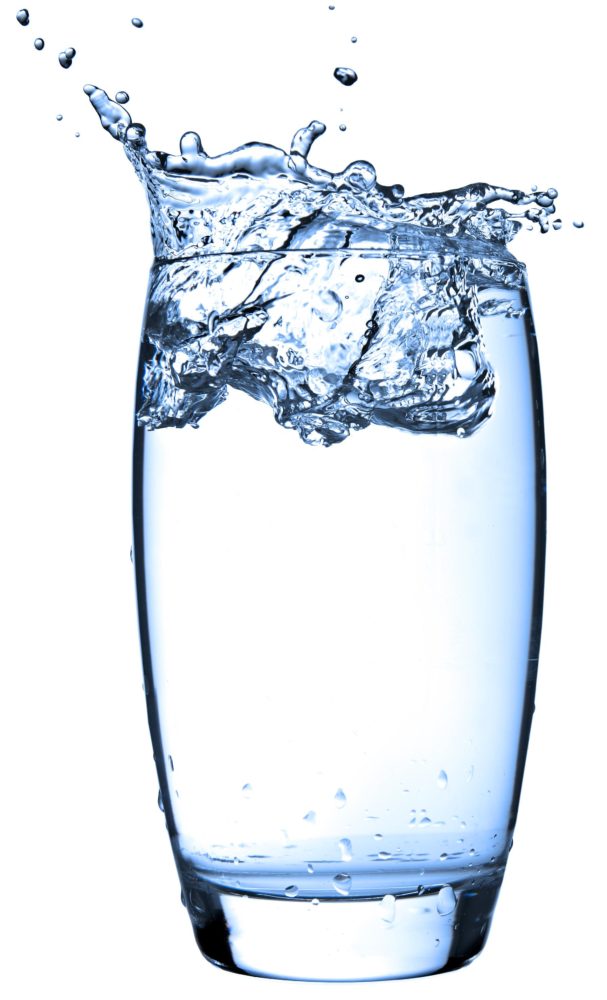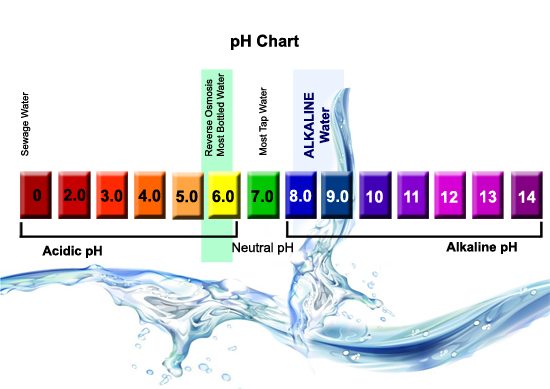
Every cell in your body needs water. For your cells—and therefore you—to function at all, to create energy, to eliminate waste, to carry out all their vital jobs, you must continuously hydrate all day long.
The two big debates?
- How much water should we drink?
- What’s the best type of water?
The answer to these are… it depends. How much toxicity does your body need to remove? How active are you?
Get 3-4 servings of fruits, vegetables and legumes every day
The first two articles here and here in this series started reducing toxicity:
Hopefully, these articles inspired you to reduce and ultimately eliminate added sugar in your life by choosing real, whole foods—foods without a label. That’s where most of us start.
If you’ve made those changes, very likely you are starting to feel better. You might have more energy, your skin probably looks better, you might have dropped a few pounds… we’re just getting started. Before we get into which foods for what problems, reduce and ultimately eliminate added sugars and swap those processed carbs for healthier whole foods.
Your next step is adequate hydration.
Taking a huge supplements program?
Supplements are not the end-all of nutritional healing. Select nutrients are vital to boost your non-working immune system, reduce chronic inflammation, and help eliminate the toxic waste that is sapping your health and energy and keeping you fat… Supplements repair years of starving the body far faster than whole foods alone—but more is not necessarily better. Most huge supplements programs come from not knowing how to get what you need from your diet. We can spend far too much money and time worried about “vitamin this” and “supplement that” yet miss the big picture.
The big picture is to make sure to get lots of whole foods.
And plenty of clean spring water.
By refined foods is meant anything in a package. Even packages with the un-regulated word “healthy” or brands that pay to use the trademarks of “heart healthy.” Added sugars are everywhere. Read the labels. Whole foods carbohydrates like buckwheat, nuts, winter squash, fruit, potatoes (whole, that you cook yourself)—shift to foods that don’t need a label.
Need more? Here’s another study: Investigators in Spain tracked 135,000 people for 7 years and found:
- more than half of us get over 70% of our daily calories from carbs;
- those high-carbohydrate diets were linked with increases in both blood cholesterol and the chemical building blocks that form cholesterol;
- those high-carb diets were associated with a 28% increased risk of death versus low-carb diets;
- contrary to popular belief, decreasing dietary fats below 10% (the current global recommendations) may cause disease;
- people with a high fat intake—about 35% of daily calories—had a 23% lower risk of early death and 18% lower risk of stroke compared to people who ate less fat.
Convinced? Just keep going, do what you can to improve a little bit each day. You’ll get there.
A key nutrient that far too many professionals never even discuss is water. If you are clogging your body with a ton of toxic chemicals and not flushing them out and through, it will clinically look like you need more supplements.
You need enough pure, clean water to detoxify
If you are still consuming a diet high in added sugars and refined, premade foods, you’ll need more water than if you are eating mostly whole foods.
Most people do well consuming about half your weight in ounces of water throughout the day.
- In other words, the 180-pound person consuming a lot of free-radical-creating carbs will need 90 ounces of water—that’s a little over 11 measuring cups—every day.
- If you’re active or live in a dry climate, you need more.
- If you eat that huge pile of veggies each meal, you need less.
If you’ve cut back your sugars and processed foods, then your next step to health is flush out all the waste that has built up over the years.
The big controversy: which water is best? Purified? Distilled? Regular water?
Don’t ask the manufacturer. I have. They all talk about this or that research but I honestly can’t find any in the published medical literature. What does that mean? Honest research gets reviewed for value and flaws by a body of peer experts. If it passes, it gets published.
I wish I could say “This is THE BEST water filter you can buy”—and send you on your merry way.
But the truth is the “best” water filter for your home depends on two factors that are different for everyone: 1. the contaminants present, and 2. the style of filter that is most practical.
Luckily, once you’ve identified those two things, the rest is easy.
First step: Handle the chlorine in your shower
Before we even start discussing drinking water, the biggest source of chlorine is taking a hot shower or bath in chlorinated water. Water is disinfected with chlorine and a similar chemical chloramine to remove threat of infectious bacteria and parasites. Chlorine and chloramine kill pests by being toxic to them; they are toxic to you also, especially your nervous system.
If your water is chlorinated, the best place to start is any of the shower filter options here from a company that honestly tests and certifies its products.
If you are low on B vitamins (60% of us are) and the amino acid taurine, you cannot process and eliminate chlorine; aldehydes (the scents) in perfumes may bother you too. Tip: taurine is high in dark poultry meat, grass-fed red meat, fish protein, and eggs. Vegan/vegetarian sources are limited, mostly brewer’s yeast (note: yeast is not recommended if you have a viral infection). And the natural B vitamins you need are found in all those foods as well as all green veggies, legumes (beans and peas), nuts, and seeds.
What’s sapping these nutrients?
- Converting carbohydrates to energy, high blood sugar, Metformin
- Taking birth control
- GERD, inflammatory bowel diseases and other digestive disorders
- Rheumatoid arthritis
- Chronic inflammation increases your body’s demand for B9 (folate) and enhances vitamin B6 degradation
While you rebalance the real cause of those health problems, at least lower the amount of chlorine your body must process. Get a shower filter.
Second step: What is contaminating your water?
Possibilities include:
- Bacteria
- Algae
- Fungi
- Parasites
- Metals like arsenic, copper and lead
- Chemical pollutants like chlorine, chloramine and fluoride are added to most municipality waters along with a host of chemicals to dissolve things we don’t want to see and fix what we don’t want to taste. From nitrates and nitrites in agricultural runoff estrogens, Prozac, and other medications, it is hard to find clean water.
Thanks to the Environmental Working Group’s new Tap Water Database, you can type in your zip code and find out exactly what contaminants are lurking in your local public water supply. Checking on 99507, our public water has exceeded arsenic levels and two other cancer-causing chemicals. The EWG doesn’t report the other potential problems but it’s a good start.
On a well or want to know more? No problem. Order this inexpensive test kit and test your water yourself. In Anchorage or surrounding areas? The folks at Alaska Pure Water will test it for you.
The US Environmental Protection Agency (EPA) sets legal limits that are considered safe for over 90 contaminants in drinking water. Safe for who? The average adult. That’s not happy news if you are among those “average” adults with genetic variations that make it more difficult to process toxic chemicals. Or if you are an infant.
Third step: How do you get those contaminants out?
First off: What is purified water?
Purified water has been filtered or processed to remove impurities like chemicals and other contaminants. There are a gazillion technologies from the simple counter-top pitcher or refrigerator filter to expensive units that distill, spin, add back minerals and alter the acid/alkaline profile. Some of these make the water worse, some better.
The honest and best unit will produce water as close to natural spring water as possible.
Filtration removes a variety of contaminants from well or tap water, depending on the filter(s) or technologies used.
Again, get your water tested and then buy the solution for what you find. Hard water high in minerals is going to be handled differently than water from agricultural areas contaminated with nitrites and nitrates from synthetic fertilizer use, pesticide and herbicides. In our bigger cities, medications like birth control and Prozac are showing up in the water supply.
Counter-top pitcher filters like Brita and others, or the filter in your refrigerator generally do not remove very much. They are better than nothing and may be better than some of the fancier systems that alter the water too much.
Popular systems that don’t produce healthy water:
Bottled water is controversial not only for the high waste of packaging but because plastics and other chemicals leach from the bottle into the water. Bisphenol-A is a well-known example and whether you buy BPA-free plastics or not, the plastic itself can leach into the water—especially when stored for months or years in warm warehouses or even in your car. Always check to make sure the water is what is says it is. And once again, the Environmental Working Group has a full report.
Reverse Osmosis filtration systems use a series of steps to remove sediment and, ultimately force the water through a very fine membrane that gets out the last remaining minerals, good or bad, leaving acidic, “hungry” water. Water naturally dissolves minerals and other compounds. Spring water naturally has minerals and other healthful and whole ions in it—that is what makes the water alkaline.
The very first thing that happens when you drink mineral-depleted “hungry” water is that it tries to restore its ions and dissolved minerals. It steals the calcium you need to build strong bones, steals the magnesium you need to produce energy, steals… it generally does not rehydrate as well as true spring water. These are losing popularity in favor of systems that leave the water closer to its natural state.
Distilled water is also “hungry.” When water boils and becomes steam, then condenses, it leaves behind the minerals. This is great for irons, not so great for bodies. In fact, distillation typically removes around 99.9% of all minerals found in tap water. Drinking water that’s low in calcium and magnesium has been associated with an increased risk of fracture, preterm birth and heart disease.
High pH systems require a rather long discussion. I won’t get into it here. Most of these systems remove impurities and then take the water through various additional steps (depending on brand theory). There is a setting that allows the owner to decide how high they want the water pH to be at the end of these steps.
Again, it’s a long discussion. Neutral—neither alkaline or acid—is pH 7.0. Spring water with it’s natural mineral content is slightly alkaline: pH 7.4-8.0. Kangan water from a machine that bears a $4000 price tag can exceed a pH of 10.0. is this good? It helped hospitalized patients who drank it for a week but there are zero studies exploring whether it is good to drink it for a lifetime. Using Nutrition Response Testing, very high pH water hasn’t tested well on anyone, yet—water is not naturally that alkaline.
Economical systems that produce healthier water
While tap water is considered safe to drink, it may still contain trace contaminants and usually has added chlorine, fluoride, and chemicals to disinfect it, make it taste better, clarify it and supposedly prevent cavities. You must know what is in your water to know what you need to get out of that water.
For example, charcoal filters remove chlorine, but not fluoride or arsenic. Fluoride is a mineral added to public drinking water supposedly to improve dental health and reduce dental decay. The research on whether fluoride can do this is not very compelling—lowering fruit juice (and especially sugar sweeteners) would prevent more dental cavities than fluoride.
The problem with fluoride is its health risks: Excessive fluoride levels can be toxic to both brain and nerve cells, and long-term exposure to high levels of fluoride has been linked to learning, memory and cognitive deficits.
What to buy?
If you live in an apartment, you probably want a system that attaches to your faucet. If you own your own home you can install something more permanent. In both cases you can get everything you need for under $150. There are very economical systems available to remove arsenic, lead, fluoride, or whatever is your concern. Try these:
Get the Flouride and Chlorine out (city water)
Countertop filter to get out fluoride (and chlorine and other nasties).
Undersink filter—generally these pay for themselves because the filters aren’t replaced as often
Address Arsenic (some well water)
Countertop filter for arsenic levels below 30 ppb (0.03 mg/l) If your arsenic level is above that, you need a double system and above 50 ppb go for the triple countertop system.
Undersink filter—generally these pay for themselves because the filters aren’t replaced as often
Remove nitrates & nitrites (some well and city waters)
Countertop filter if you live in a very agricultural area where nitrates are high, you need to remove both the nitrates and the other common contaminants. This requires two filters.
Undersink filter—this is a replacement cartridge that is nitrate/nitrite specific for 3-filter under sink systems.
Hopefully that gives you some tools. If you have any questions please feel free to email me at marie@synergynutrition.info
Drink water to your Health!

Arbuckle, T. E., Hrudey, S. E., Krasner, S. W., Nuckols, J. R., Richardson, S. D., Singer, P., … Waller, K. (2002). Assessing exposure in epidemiologic studies to disinfection by-products in drinking water: report from an international workshop. Environmental Health Perspectives, 110(Suppl 1), 53–60.
Dehghan, M., Mente, A., Zhang, X., Swaminathan, S., Li, W., Mohan, V., . . . Prospective Urban Rural Epidemiology study, investigators. (2017). Associations of fats and carbohydrate intake with cardiovascular disease and mortality in 18 countries from five continents (PURE): a prospective cohort study. Lancet, 390(10107), 2050-2062.
Ullah, R., Zafar, M. S., & Shahani, N. (2017). Potential fluoride toxicity from oral medicaments: A review. Iranian Journal of Basic Medical Sciences, 20(8), 841–848.
Villanueva, C. M., Gracia-Lavedan, E., Bosetti, C., Righi, E., Molina, A. J., Martín, V., … Kogevinas, M. (2017). Colorectal Cancer and Long-Term Exposure to Trihalomethanes in Drinking Water: A Multicenter Case–Control Study in Spain and Italy. Environmental Health Perspectives, 125(1), 56–65.
Weidman, J., Holsworth, R. E., Brossman, B., Cho, D. J., St.Cyr, J., & Fridman, G. (2016). Effect of electrolyzed high-pH alkaline water on blood viscosity in healthy adults. Journal of the International Society of Sports Nutrition, 13, 45.




Leave a Reply
You must be logged in to post a comment.